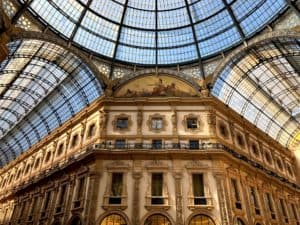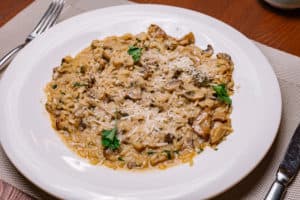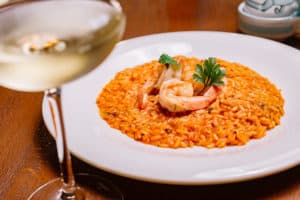In Milan, where fashion and architecture leave visitors in awe, the culinary scene, marked by the Milan Food Tour, offers its own spectacle of flavors. This tour, however, is just the beginning of a story that deeply entwines with the city’s heart. Milan’s gastronomic pride, risotto, represents its rich culinary traditions. The risotto is such an iconic milanese dish, that we thought we needed an in-depth post about it. So here we are!
Milan Unveiled: From Fashion to Flavors
Milan is globally renowned as a fashion powerhouse, offering an equally compelling culinary narrative. This city, where modernity intertwines with rich historical threads, has evolved from a medieval trade hub into a vivid cosmopolitan center. This transformation is not just reflected in the stunning architecture and high-fashion streets but also in its diverse gastronomy.
The essence of Milan lies in its ability to harmonize the old with the new. The city’s ancient cathedrals and art, reminiscent of its historical grandeur, coexist with contemporary fashion houses and skyscrapers. This juxtaposition has influenced Milan’s skyline and also its dining tables. The culinary scene in Milan, much like its fashion, is about a fusion of tradition with innovation.
As Milan has transformed, so have its culinary offerings. The city’s position as an international hub has invited influences from various cultures, enriching its food landscape. Yet, amidst these global flavors, risotto remains a steadfast symbol of Milanese culinary identity, a dish that narrates the city’s past while embracing its present.

Risotto: A Taste of Milanese Elegance
Risotto, a dish that effortlessly conveys the essence of Milanese elegance. It is a culinary artwork, deeply rooted in the traditions and history of Milan. At its core, risotto celebrates the harmony of taste, texture, and ingredients, brought together through meticulous cooking techniques.
The dish begins with the selection of the right kind of rice, typically Arborio, Carnaroli, or Vialone Nano, known for their ability to absorb flavors while maintaining a firm texture. The process of toasting the rice in butter or olive oil, before slowly adding broth, is crucial. This method allows the rice to release its starch, creating the signature creamy consistency without compromising the grains’ integrity.
Each spoonful of risotto offers a luxurious silkiness interspersed with the gentle bite of al dente rice. The flavors are often subtle yet complex, with a depth that speaks to the high-quality ingredients used. Whether it’s enriched with the earthiness of mushrooms, the robustness of osso buco, or the luxuriousness of saffron in the Risotto alla Milanese, each variation reflects Milan’s rich culinary landscape.
The elegance of risotto also lies in its presentation. Often served as a primo, or first course, it sets the stage for a sophisticated dining experience. Its appearance, often simple and unadorned, belies the skill and patience required in its preparation.
Risotto’s Timeless Tale: Milan’s Culinary Heritage Unfolded
Historically, risotto’s beginnings can be traced back to the Middle Ages when rice was first introduced to Italy by the Arabs. Milan, situated in the Po Valley, proved to be an ideal location for rice cultivation due to its wet, marshy terrain. Over time, rice became a staple ingredient in the Lombardy region, setting the stage for the birth of risotto as a quintessential Milanese dish.
The transformation of simple rice into risotto is a story of culinary innovation. It began as a humble peasant dish, a practical way to use the abundant local rice. However, over the centuries, it evolved into a refined, luxurious meal, one that embodied the sophistication of Milanese society. This evolution mirrored Milan’s own journey from a regional center to a global fashion and cultural capital.

The Story of Saffron in Milanese Risotto
Saffron, the golden spice that gives Risotto alla Milanese its distinctive color and flavor, has a story as intriguing as the city of Milan itself.
Saffron’s journey to Milan begins along the ancient Silk Road, the historic network of trade routes that connected the East and West. Originally cultivated in the Middle East and Asia, saffron found its way to Europe through the intricate channels of spice trade. Its rarity and value made it a sought-after commodity among the wealthy and the elite.
The introduction of saffron to Italian cuisine, particularly to risotto in Milan, is shrouded in legend and lore. The most popular tale recounts the story of Valerius, a young apprentice working on the stained glass windows of Milan’s iconic Duomo in the 16th century. Valerius, known for using saffron to tint the glass gold, playfully added the spice to a pot of risotto at his master’s wedding, giving birth to the golden-hued Risotto alla Milanese.
Beyond its alluring color, saffron imparts a subtle earthiness and a hint of sweetness to risotto, elevating the dish to a higher level of gastronomic delight. Its inclusion in the recipe symbolizes Milan’s openness to outside influences and its capacity to adapt and transform them into something uniquely its own.
In Milan, saffron is a cultural icon, representing the city’s rich history of trade, art, and culinary innovation. The careful cultivation and harvesting of saffron threads, derived from the Crocus sativus flower, is a testament to the dedication and skill of those who bring this precious ingredient to Milanese kitchens.

The Art of Perfect Risotto: Techniques and Tips from Milanese Chefs
Crafting the perfect risotto is an art form, a delicate balance of technique, timing, and passion. Milanese chefs, guardians of this culinary tradition, hold the secrets to transforming simple ingredients into a dish of sublime elegance. Their wisdom is not just about following a recipe but understanding the soul of risotto.
The choice of rice is the cornerstone of an excellent risotto. In Milan, chefs prefer varieties like Arborio, Carnaroli, or Vialone Nano, known for their ability to absorb flavors while maintaining a firm texture. The perfect risotto rice should create a creamy consistency without becoming mushy.
Toasting the rice, a critical step often overlooked, is essential. This process, known as ‘tostatura’, involves gently cooking the rice in a little oil or butter until it becomes translucent. This technique seals in the grains, ensuring they cook evenly and release their starches slowly, contributing to the risotto’s creaminess.
The addition of liquid is a ritual in itself. Milanese chefs recommend warm broth, added ladle by ladle, allowing the rice to slowly absorb it. This gradual process, requiring constant stirring, is a labor of love that infuses the risotto with flavor and achieves the desired texture.
Patience is key to risotto making. Rushing can lead to an undercooked or unevenly cooked dish. Milanese chefs advocate a slow and steady approach, letting the rice dictate the pace. The risotto is ready when the rice is ‘al dente‘ – tender yet firm to the bite.
Beyond the basics, each chef in Milan brings their personal touch to risotto. Some may add a splash of white wine before the broth for acidity, while others finish the dish with a generous knob of butter (‘mantecare’) for richness. This final step, done off the heat, gives risotto its signature velvety texture.
Milanese chefs also emphasize the importance of serving risotto promptly. The dish continues to cook with its residual heat, so timing is crucial to preserve its ideal consistency. A perfect risotto should be fluid, almost wave-like when plated, not too dry or too runny.
The Milan Food Tour is a sensory expedition that invites guests to savor the rich flavors of Milanese cuisine at its finest. Each stop on the tour is a revelation, offering a taste of local favorites and gourmet specialties. Beginning with the succulent Arancina from Palermo, participants are introduced to the diversity of Italian regional cuisine right in the heart of Milan. As the journey continues, the tour weaves through the historical Navigli area, where the allure of Milan as an international culinary hub becomes evident.
The highlight, of course, is the beloved Risotto, a Milanese masterpiece. Here, guests not only indulge in this creamy, saffron-infused delight but also uncover the secrets of its preparation, learning about the finesse involved in creating this iconic dish. Alongside Risotto, the tour features other gastronomic gems like Panzerotto Pugliese and luxurious fruit tartlets, each offering a distinct flavor that represents a facet of Milan’s culinary identity. The tour culminates near the majestic Dome of Milan, leaving participants with a sweet aftertaste of the city’s rich gastronomic culture. For a chance to experience this culinary journey, we warmly invite you to book your Milan Food Tour and immerse yourself in the exquisite flavors of Milan.
